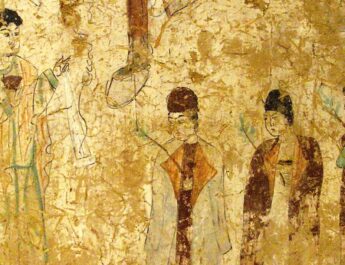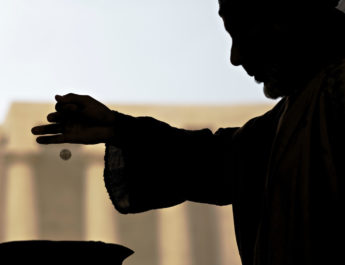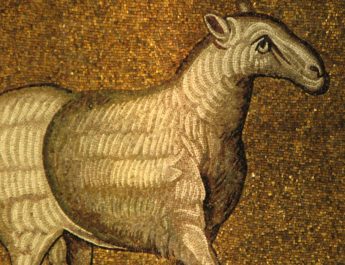Numbers 21:4-9
Holy Cross ABC
BibleHub
4 From MountA HorB they set outC by the wayD to the RedE Sea,F
Notes on verse 4a
A “Mount” = har. Perhaps related to “Hor” in v4. See note B below.
B “Hor” = Hor. 12x in OT. Perhaps from har (mountain, hill); from harar (mountain, hill). This is Hor, the name of two mountains – one in Idumaea and another in Syria.
C “set out” = nasa. This is properly pulling up as when one pulls up tent pegs or stakes. This would imply striking tents in order to start a journey. So this could be bring, pullout, set out, journey, or cause to go away.
D “way” = derek. From darak (to tread, march, to walk. Can also mean affixing a string to a box since one needs to step on it to bend it in the process; so also an archer). This is a road as a thing that is walked on. Can be used figuratively for the path that one’s life takes or how one chooses to live one’s life.
E “Red” = suph. Perhaps from Egyptian twfi (reeds). This is reeds or rushes. It can be used particularly to refer to papyrus, or a flag. This is https://www.abarim-publications.com/Dictionary/sa/sa-p-pfin.html#.XzHCuChKhPY
F “Sea” = yam. Root may mean to roar. This is the sea, often referring to the Mediterranean. It comes from the root in the sense of the roar of crashing surf. This word is sometimes used for rivers or other sources of water. It can mean to the west or to the south.
to go aroundG the landH of Edom;I but the peopleJ became impatientK on the way.
Notes on verse 4b
G “go around” = sabab. This is turning around, going around; to surround, cast, walk, fetch. It is to revolve or border in a literal or figurative sense.
H “land” = erets. Root may mean to be firm. This is earth, ground, field land, or country.
I “Edom” = Edom. From the same as adom (to be red or flushed). This is Edom or Idumaea. It means red.
J “people” = nephesh + am. Nephesh is related to naphash (to refresh or be refreshed). This is soul, self, person, emotion. It is a breathing creature. Can also refer to appetites and desires. Am is from amam (to darken, hide, associate; creating shadows by huddling together). This is people or nation. It can be used specifically for a tribe, collectively of troops or armies, or figuratively to refer to a flock of animals.
K “became impatient” = qatsar. This is to cut down, be short, reap, curtail. It is used especially for harvesting grass or grain. Figuratively, it can mean to be discouraged or grieve.
5 The people spokeL against GodM and against Moses,N
Notes on verse 5a
L “spoke” = dabar. This is generally to speak, answer, declare, or command. It might mean to arrange and so to speak in a figurative sense as arranging words.
M “God” = Elohim.
N “Moses” = Mosheh. From mashah (to pull out in a literal or figurative sense, to draw out) OR from Egyptian mes or mesu (child, son i.e. child of…). This is Moses – the one drawn out from the water, which is to say, rescued. If derived from the Egyptian, his name would share a root with Rameses and Thutmose.
“Why have you brought us upO out of EgyptP to dieQ in the wilderness?R
Notes on verse 5b
O “brought…up” = alah. This is to go up, approach, ascend, be high, be a priority; to arise in a literal or figurative sense.
P “Egypt” = Mitsrayim. Perhaps from matsor (besieged or fortified place, bulwark, entrenchment; something hemmed in; a siege or distress or fastness); from tsur (to confine, besiege, to cramp). This is Egypt.
Q “die” = mut. This is to die in a literal or figurative sense. It can also refer to being a dead body.
R “wilderness” = midbar. Related to “spoke” in v5. From dabar (see note L above). This is mouth or speech. It can also be desert or wilderness. Additionally, it can be used for a pasture to which one drives cattle.
For there is no foodS and no water,T and weU detestV this miserableW food.”
Notes on verse 5c
S “food” = lechem. From lacham (to eat, feed on). This is bread, food, loaf. It can refer to food more generally for people or for animals.
T “water” = mayim. This is water, waters, or waterway in a general sense. Figuratively, it can also mean juice, urine, or semen.
U “we” = nephesh. Same as “people” in v4. See note J above.
V “detest” = quts. 9x in OT. This is to feel dread, be distressed, tired, terrorized, be disgusted, be anxious, abhor.
W “miserable” = qeloqel. 1x in OT. From qalal (to be little, insignificant, swift; to bring down in esteem, create contempt, curse). This is miserable, insubstantial, lacking worth, or contemptible.
6 Then the LordX sentY poisonousZ serpentsAA among the people, and they bitBB the people, so that many IsraelitesCC died.
Notes on verse 6
X “Lord” = YHVH. From havah (to be, become) or hayah (to come to pass, become, be). This is the name of the God of Israel, the self-existent and eternal one, the tetragrammaton. This pronunciation has been lost to time so “Lord” is generally used in its place.
Y “sent” = shalach. This is to send out, away, send for, forsake. It can also mean to divorce or set a slave free.
Z “poisonous” = saraph. 7x in OT. From saraph (to burn or kindle). This is burning or fiery, i.e. poisonous. It can be a serpent or a seraph.
AA “serpents” = nachash. Perhaps from nachash (to practice divination, learn by experience; to hiss as in whispering a spell). This is a serpent or snake. Used for the Serpent in the garden of Eden.
BB “bit” = nashak. 16x in OT. This is bite or sting as from a snake. Figuratively, it is lending with interest.
CC “Israelites” = am…+ Yisrael. Literally “people of “Israel.” Am is the same as “people” in v4. See note J above. Yisrael is from sarah (to persist, exert oneself, contend, persevere, wrestle, prevail) + el (God or god). This is God strives or one who strives with God; new name for Jacob and for his offspring. This refers to the people and to the land.
7 The people came to Moses and said, “We have sinnedDD by speaking against the Lord and against you; prayEE to the Lord to take awayFF the serpents from us.” So Moses prayed for the people.
Notes on verse 7
DD “sinned” = chata. This is properly to miss, and so figuratively it is used for sinning, bearing the blame. It implies a forfeiture or loss of something.
EE “pray” = palal. This is to judge for oneself or in an official capacity. It can also mean to pray or make supplication, to entreat.
FF “take away” = sur. This is to turn aside in a literal or figurative sense – to depart, decline, rebel, remove, or withdraw.
8 And the Lord said to Moses, “Make a poisonous serpent, and setGG it on a pole;HH and everyone who is bitten shall lookII at it and live.”JJ
Notes on verse 8
GG “set” = sim. This is to put or place in a literal or figurative sense. It can be appoint, care, change, make, and may other things.
HH “pole” = nes. From nasas (to be high, easy to see, sparkling, to gleam, to raise a flag or signal). This is a flag, pole, sail, warning, signal, token.
II “look” = raah. This is to see in a literal or figurative sense so stare, advise, think, view.
JJ “live” = chayay. 17x in OT. This is to live, save live, or revive.
9 So Moses made a serpent of bronze,KK and putLL it upon a pole; and whenever a serpent bit someone,MM that person would lookNN at the serpent of bronze and live.
Notes on verse 9
KK “bronze” = nechosheth. Perhaps related to “serpents” in v6. Perhaps from nechushah (copper, bronze, brass – something made from this metal like a coin or fetter; something that is considered base in contrast to gold or silver.; from nachush (made of bronze or brass, coppery; figuratively, hard); from nachash (see note AA above). This is bronze, copper, steel, brass or something made from copper. So, it could be a coin or chains. It can also figuratively mean something considered lesser in contrast to gold or silver.
LL “put” = sim. Same as “set” in v8. See note GG above.
MM “someone” = ish. Perhaps from enosh (human, humankind, mortal); from anash (to be weak, sick, or frail). This is man, husband, another, or humankind.
NN “look” = nabat. This is to behold, look at intently, consider, or scan. It can mean to have respect or regard someone favorably.
Image credit: “Staff at Sunset” – the Brazen Serpent Monument on Mount Nebo. Photo by JoTB, 2009.




